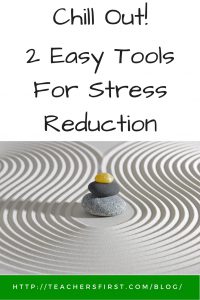 Are there times during the school year when you or your students stress out? There is no wonder why. Teachers strive to keep up with daily classroom activities along with paper work, interaction with parents and administrators, and adherence to an ever-growing list of new standards and regulations. Students are under pressure to keep up academically, address demands on their home life, and also take part in sports and social activities. Put this together with limited time during the day to accomplish everything and we have the perfect recipe for stress.
Are there times during the school year when you or your students stress out? There is no wonder why. Teachers strive to keep up with daily classroom activities along with paper work, interaction with parents and administrators, and adherence to an ever-growing list of new standards and regulations. Students are under pressure to keep up academically, address demands on their home life, and also take part in sports and social activities. Put this together with limited time during the day to accomplish everything and we have the perfect recipe for stress.
Here are two tools to consider using both in your classroom and at home for those times when you need some stress reduction. Sometimes the very simple things work the best, and these both fit into that “simple” category.
Calm is a website offering calming sights and sounds for relaxation with just a few additional features to enhance your meditative experience:
- Set the length of your Calm experience with choices on the site in 2, 5, 10, 15, or 20 minutes.
- Change settings for different relaxing scenes, including beaches, lakes, and mountains.
- Adjust the volume as needed.
- Download apps for Apple and Android products for use on any device.
Another website from the same company is Do Nothing for Two Minutes. Just as the title states, this site forces the user to relax and do nothing. Touch your keyboard or move your mouse and the two-minute timer resets. The simplicity of this site is absolute genius, and it doesn’t offer any additional features to complicate the process. Now that is stress-free! Click on the site, listen, and keep your hands off of the computer!
Consider using these tools to incorporate relaxation into your daily classroom routine to help both you and your students:
- Display one of these sites on your interactive whiteboard as a relaxing, peaceful way for students to enter your classroom.
- Use after an active or boisterous activity to help students (and you) calm down and de-stress.
- Create a link on your classroom computers to provide a quiet, relaxing spot for students who need a time out.
- Create a 5-minute meditation time at the end of each school day for you and your students to relax and reflect on the day’s events.
- If your school’s cafeteria has a whiteboard, suggest offering one of these sites during lunchtime to help maintain a calming environment. Hopefully, you have access to speakers to achieve maximum effect.
- Share these sites with students as you teach study skills and how to focus while studying.
- Set a timer and display one of the sites during periods of “think” time.
Calm and Do Nothing for Two Minutes are also perfect when working with special needs students, especially those on the autism scale. Studies have shown that regular relaxation is the most effective treatment for autistic spectrum disorders (Weisz, McCarty, and Valeri, 2006). Since these students may experience more anxiety and mood changes than other students, having these tools available provides a quick and easy (also free) way to provide support for their specific needs.
- Allow students to use a mobile device with headphones as they listen to calming music during work times.
- Have students view and listen to Calm using a predetermined time period before beginning tasks that they find difficult.
- Be sure to share these two sites with parents for use at home.
- Most autistic students prefer consistency and change causes problems in their daily routine, use one of these tools to begin and end each school day in a consistent manner.
Consider the applications for these two sites in your professional life, for some, this may be the most stressful part of your job!
- Display and play one of these sites on your interactive whiteboard during parent/teacher conferences. Parents are often nervous to hear about their child’s progress, and teachers may also be stressed when discussing student progress. Use one of these tools to provide a calm, quiet atmosphere for conversations.
- Use these sites as time management tools during professional development sessions – set the timer and have participants share ideas as a group or individually, use calming sounds to transition between different discussions or activities, or share as a quick “time out” if things get heated at any time.
- Use these sites for background music on your computer as you grade papers, prepare lesson plans, or sort through daily emails.
- Share these sites with coworkers who can use a little help with stress management.
As teaching continues to become more and more stressful, these two tools offer some quick and easy relaxation techniques for both teachers and students. What tools can you suggest that help you relax or what other ideas do you have for using these tools in the classroom?

